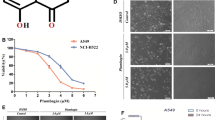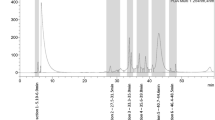Abstract
Naringenin (NGEN), a naturally occurring citrus flavonone, has shown cytotoxicity in various human cancer cell lines as well as inhibitory effects on tumor growth. It has been also shown to access the brain and there is an increasing interest in its therapeutic applications. The up-regulated expression of Cx43 leads to the suppression of tumorigenicity with promoted apoptotic events. In this study, we investigated the in vivo effect of NGEN in fostering apoptosis in cerebrally implanted C6 glioma cells rat model. We analysed the expression of Cx43, caspase-3, caspase-9, Cyt C, Bcl-2 and Bax in vivo by immunoblot analysis and the ultra structure of brain cells by transmission electron microscopy. Supplementation of NGEN to experimental animals modulated Bcl-2/Bax ratio and up-regulation of caspase-3 and 9. NGEN was also found to up-regulate the expression of Cx43. These findings provide evidence that NGEN’s apoptotic effect, modulation of Bcl-2/Bax ratio leads to release of Cyt C from mitochondria, thereby activation of caspase-3 and caspase-9 is mediated by enhanced expression of Cx43. These observations were well supported by the transmission electron microscopic results which showed the characteristic apoptotic features. In conclusion, our findings demonstrate that NGEN promotes apoptosis in rat C6 glioma model.



Similar content being viewed by others
References
Onda K, Davis RL, Shibuya M, Wilson CB, Hoshino T (1994) Correlation between the bromodeoxyuridine labeling index and the MIB-1 and Ki-67 proliferating cell indices in cerebral gliomas. Cancer 74:1921–1926
Cerame MA, Guthikonda M, Kohli CM (1985) Extraneural metastasis in gliosarcoma: a case report and review of the literature. Neurosurgery 17:413–418
Sanai N, Alvarez-Buylla A, Berger MS (2005) Neural stem cells and the origin of gliomas. N Engl J Med 353:811–822
Stupp R, Reni M, Gatta G, Mazza E, Vecht C (2007) Anaplastic astrocytoma in adults. Crit Rev Oncol Hematol 63(1):72–80
Lampson LA (2001) New animal models to probe brain tumor biology, therapy and immunotherapy: advantages and remaining concerns. J Neuro Oncol. 53:275–287
Yamasaki H, Naus CCG (1996) Role of connexin genes in growth control. Carcinogenesis 17:1199–1213
Huang RP, Fan Y, Hossain MZ, Peng A, Zeng ZL, Boynton AL (1998) Reversion of the neoplastic phenotype of human glioblastoma cells by connexin 43 (cx43). Cancer Res 58:5089–5096
Huang RP, Hossain MZ, Huang R, Gano J, Fan Y, Boynton AL (2001) Connexin 43 (cx43) enhances chemotherapyinduced apoptosis in human glioblastoma cells. Int J Cancer 92:130–138
Udawatte C, Ripps H (2005) The spread of apoptosis through gap-junctional channels in BHK cells transfected with Cx32. Apoptosis 10:1019–1029
Owuor ED, Kong (2002) Antioxidants and oxidants regulated signal transduction pathways. Biochem Pharmacol 64:765–770
Vermeulen K, Van Bockstaele DR, Berneman ZN (2005) Apoptosis: mechanisms and relevance in cancer. Ann Hematol 84:627–639
Henson PM, Bratton DL, Fadok VA (2001) Apoptotic cell removal. Curr Biol 11:795–805
Green DR, Evan GI (2002) A matter of life and death. Cancer Cell 1:19–30
Vincenz C, Dixit VM (1997) Fas-associated death domain protein interleukin-1beta-converting enzyme 2 (FLICE2), an ICE/Ced-3 homologue, is proximally involved in CD95- and p55-mediated death signaling. J Biol Chem. 272:6578–6583
Green DR, Reed JC (1998) Mitochondria and apoptosis. Science 281:1309–1312
Gayathri R, Gunadharini DN, Arunkumar A, Senthilkumar K, Krishnamoorthy G, Banudevi S, Vignesh RC, Arunakaran J (2009) Effects of diallyl disulfide (DADS) on expression of apoptosis associated proteins in androgen independent human prostate cancer cells (PC-3). Mol Cell Biochem 320:197–203
Chen D, Chen MS, Cui QC, Yang H, Dou QP (2007) Structure–proteasome–inhibitory activity relationships of dietary flavonoids in human cancer cells. Front Biosci. 12:1935–1945
Kawaii S, Tomono Y, Katase E, Ogawa K, Yano M (1999) HL-60 differentiating activity and flavonoid content of the readily extractable fraction prepared from citrus juices. J Agric Food Chem 47:128–135
Kanno S, Tomizawa A, Ohtake T, Koiwai K, Ujibe M, Ishikawa M (2006) Naringenin-induced apoptosis via activation of NF-kappaB and necrosis involving the loss of ATP in human promyeloleukemia HL-60 cells. Toxicol Lett 166:131–139
Youdim KA, Qaiser MZ, Begley DJ, Rice-Evans CA, Abbott NJ (2004) Flavonoid permeability across an in situ model of the blood–brain barrier. Free Radic Biol Med 36:592–604
Nobuhisa N, Hiroshi S, Masaru A, Kimiyoshi H (1993) Invasion of experimental rat brain tumor: early morphological changes following microinjection of C6 glioma cells. Acta Neuropathol 86:117–125
Fiddo RJ, Tatham AS, Shewry PR (1995) Western blotting analysis. Methods Mol Biol 49:423–437
La Vecchia C, Tavani A (1998) Fruits and vegetables, and human cancer. Eur J Cancer Prev 7:3–8
Kanno A, Ayako TA, Takako HA, Yuu OA, Ai Shouji A, Mayuko UA, Takaharu O AB, Katsuhiko KB, Masaaki ISA (2005) Inhibitory effects of Naringenin on tumor growth in human cancer cell lines and sarcoma S-180-implanted mice. Biol Pharm Bull 28(3):527–530
Park C, Jin CY, Kim GY, Choi IW, Kwon TK, Choi BT, Lee SJ, Lee WH, Choi YH (2008) Induction of apoptosis by esculetin in human leukemia U937 cells through activation of JNK and ERK. Toxicol Appl Pharmacol 227:219–228
Vijayababu MR, Kanagaraj P, Arunkumar A, Ilangovan R, Aruldhas MM, Arunakaran J (2005) Quercetin-induced growth inhibition and cell death in prostatic carcinoma cells (PC-3) are associated with increase in p21 and hypophosphorylated retinoblastoma proteins expression. J Cancer Res Clin Oncol 131:765–771
Sabarinathan D, Vanisree AJ (2010) Naringenin, a flavanone alters the tumorigenic features of C6 glioma cells. Biomed Pharmacother (in press)
Esposti MD, Dive C (2003) Mitochondrial membrane permeabilisation by Bax/Bak. Biochem Biophys Res Commun 304:455–461
Letai A (2005) Pharmacological manipulation of Bcl-2 family members to control cell death. J Clin Invest 115:2648–2655
Madhavi S, Moodbidri, Neelam V, Shirsat (2005) Activated JNK brings about accelerated apoptosis of Bcl-2 overexpressing C6 glioma cells on treatment with tamoxifen. J Neurochem 92:1–9
Amelio MD, Tino E, Cecconi F (2008) The apoptosome: emerging insights and new potential targets for drug design. Pharm Res 25:740–751
Ramakrishnan G, Lo Muzio L, Elinos-Báez CM, Jagan S, Augustine TA, Kamaraj S, Anandakumar P, Devaki T (2009) Silymarin inhibited proliferation and induced apoptosis in hepatic cancer cells. Cell Prolif 42:229–240
Karamitopoulou E, Cioccari L, Jakob S, Vallan C, Schaffner T, Zimmermann A, Brunner T (2007) Active caspase 3 and DNA fragmentation as markers for apoptotic cell death in primary and metastatic liver tumors. Pathology 39:558–564
Author information
Authors and Affiliations
Corresponding author
Rights and permissions
About this article
Cite this article
Sabarinathan, D., Mahalakshmi, P. & Vanisree, A.J. Naringenin promote apoptosis in cerebrally implanted C6 glioma cells. Mol Cell Biochem 345, 215–222 (2010). https://doi.org/10.1007/s11010-010-0575-6
Received:
Accepted:
Published:
Issue Date:
DOI: https://doi.org/10.1007/s11010-010-0575-6




